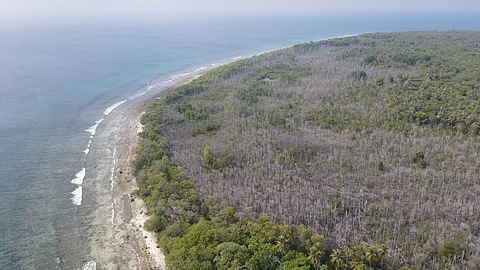

In 2020, the Maldives witnessed an alarming dieback of nearly a quarter of its mangrove forests. Now, a new study revealed the culprit: Record-high sea levels, driven by the climate pattern Indian Ocean Dipole (IOD), inundated these vital coastal defenders with salt-laden waters, which caused the forests to slowly decline before perishing.
Between 2017 and 2020, the sea levels rose by about 30 milimetres in the small island, drowning the mangroves and putting them in salinity stress, stated the report published in the journal Scientific Reports on November 12, 2024. Since 2020, several islands in the Maldives have lost more than half of their mangrove forests.
The IOD is a climate pattern that influences wind, sea surface temperatures and rainfall in the Indian Ocean basin. During the positive phase between 2019 and 2020, the western Indian Ocean, where the Maldives is situated, experienced warmer sea surface temperatures and higher sea levels due to ocean expansion, while the eastern Indian Ocean saw cooler waters and reduced sea levels.
Mangroves are highly productive ecosystems that support local livelihoods and provide a natural barrier against coastal erosion, helping mitigate climate change impacts and extreme weather events such as cyclones and typhoons.
The 900 km-long archipelago, located in the central Indian Ocean, is the world’s lowest-lying nation, standing at less than 1.5 metres above mean sea level. The Maldives hosts 15 mangrove species across at least 150 islands, of which four exhibit low salt tolerance, while five show moderate tolerance, the paper noted.
The dieback primarily affected Bruguiera cylindrica, a species with low salt tolerance and lacking salt glands.
A group of scientists, headed by Lucy Carruthers and Vasile Ersek from Northumbria University's Department of Geography and Environmental Sciences, integrated sea level evidence, climate data and remote sensing with field studies of sediment geochemistry and tree ring analysis to examine the mangrove dieback.
Satellite images revealed that prolonged exposure to seawater from high sea levels caused a significant influx of saline water, increasing porewater salt concentrations in the soil. The researchers' of mangrove wood also revealed that dead trees showed more severe signs of salinity stress compared to living ones. This stress indicates that the trees' roots struggled to cope with increased salt levels, which greatly contributed to their death.
“Porewater salinity was likely exacerbated by increased evapotranspiration due to the high temperatures in 2020. As salinity tolerances were exceeded, sediment accretion decreased, increasing soil submergence and further increasing salinity stress. We suggest this mechanism created a positive feedback loop that likely led to the observed tree mortality,” the study noted.
Due to the small land area, coastal development and low sediment deposition, the mangroves could not migrate landward, the scientists found. To cope with rising sea levels, mangroves must adapt by increasing sediment accumulation at the surface, but the rapid sea level rise prevented mangroves on low-lying Caribbean and Pacific islands from keeping pace.
“Failure to adjust to sea-level rise results in the permanent submergence of the mangrove sediment surface, altering sediment biogeochemistry, which may cause substrate collapse and tree mortality,” the scientists observed.
The study estimated that 26 per cent of Maldivian islands with mangrove forests were impacted, with some inhabited and uninhabited islands losing more than half of their mangrove cover.
Notably, no major storms or tropical cyclones occurred in the region preceding the dieback, nor did local anthropogenic factors contribute, as the dieback also affected uninhabited islands.
The scientists said that the event should be considered as a warning bell as global sea levels are expected to rise between 0.43 and 0.83 metres by 2100 under different carbon dioxide emission scenarios.
“These findings revealed the vulnerability of mangrove ecosystems to rapid sea-level rise and highlighted the urgent need for adaptive conservation strategies in Small Island Developing States,” the study observed.
Citing an instance of Guinea-Bissau in West Africa, the study highlighted that 96 per cent of small-scale fishers rely on mangroves for their livelihoods. In the Caribbean, commercially important species’ biomass more than doubles when their habitat is linked to mangrove forests. With mangrove loss, Small Island Developing States become increasingly vulnerable to sea level rise and natural hazards.
“For example, six out of the 10 countries most at risk from a one-in-250-year cyclone are Small Island Developing States. Further, Antigua and Barbuda, in the Caribbean, have the highest relative average annual losses globally of gross domestic product (GDP) associated to cyclone wind, while the Bahamas and Dominica have the highest relative risk with respect to storm surges,” the study said.
Scientists warned that extreme climate events driven by climate change threaten mangroves globally, pushing these ecosystems to their tipping points. Such events can be influenced by ocean-atmospheric processes, such as the El Niño-Southern Oscillation (ENSO) and the IOD, causing significant shifts in sea level, rainfall and temperature.
Citing an example from Australia in 2015 and 2016, the study noted that an ENSO-driven sea level drop of about 20 centimetres led to a prolonged drought and widespread mangrove dieback. In the Maldives, sea level rise due to extreme climate phenomena could further increase mangrove vulnerability.